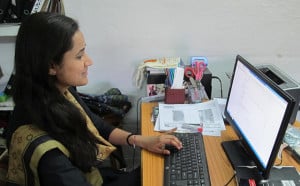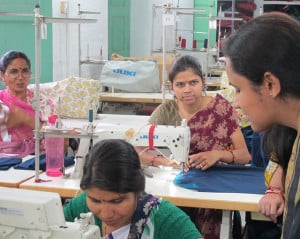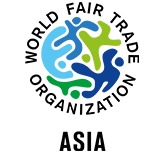
Shubhangi Singh Rathore works as a Production Merchandiser at Sadhna Handicrafts in Udaipur, India.
As a Production Merchandiser at Sadhna, I follow up with suppliers and coordinate the organisation’s internal production related work. I love my work. I studied my masters in Fashion Management and took this particular work as a profession. I am now implementing and executing the theory and knowledge that I have gained from studying.
 Before working at Sadhna, I was working in Delhi as a Buyer in the ladies ethnic department with Texas Pacific Group (TPG) Wholesale Pvt. ltd-Vishal Mega Mart. They’re the biggest private equity firm, owning Visual Mega Mart, one of the biggest retail chains in India. It’s huge. That was my first job.
Before working at Sadhna, I was working in Delhi as a Buyer in the ladies ethnic department with Texas Pacific Group (TPG) Wholesale Pvt. ltd-Vishal Mega Mart. They’re the biggest private equity firm, owning Visual Mega Mart, one of the biggest retail chains in India. It’s huge. That was my first job.
When I was a child, I thought I would become a naval officer! I used to watch a television program that used to play on Doordarshan and the name was Abhiman, which was based on the navy. My career aspirations changed every now and then, but that was the very first initial idea in my mind.
Soon after my graduation I got more inclined towards brands. This is because my friends were very brand savvy. Until the time of graduation, I was not a very brand savvy person. After meeting my friends who were quirky, I started hearing words like Zara, H&M and Abercrombie and Fitch. It sounded to me like there was a big brand garment industry out there.
My mum always used to compliment my eye. She would say I have a great taste in colour combinations and styling. Even if not always in regards to my own styling! So I thought fashion industry was a good choice for me to pursue a career with.
When I started my career in fashion I worked as a Buyer, now I am on the flip side, I am a vendor. When I was a buyer I was dealing with the vendors and regularly facing some challenges, such as with vendor management, timely deliveries and sales at better mark ups. On the other side, I know what the challenges are. Now with the blend of both jobs, I am able to bridge that gap. It’s not ethnic, western, whole, woven or knits, it’s about the knowledge that you acquire and gain and using this to get better designs. I will stay in production and upgrade my skills.
I decided to come back to my home town as it had been quite a long time away with my studies, internships, working and everything. I found some work in my own home town within the fashion industry. I was so lucky to get associated with Sadhna.
 Five years down the line I see myself as a Category Head. This could be either with Sadhna, if it grows and thinks of having Category Heads in the future, or maybe with another brand.
Five years down the line I see myself as a Category Head. This could be either with Sadhna, if it grows and thinks of having Category Heads in the future, or maybe with another brand.
As a Buyer, I have been to places where there are women operators and male operators. In other factories and setups I have been to people are more confined. They enter work and go. At Sadhna it’s more of a family. I feel whatever thoughts you have in mind when walking into the factory you can share it easily with another person. Here through chatting people can shed off their office and home load and when they exit, they take happy memories. I always notice that with the tone when the pitch is high everything is normal. Sometimes I witness quarrels, but it’s when people speak in whispers, “I think something fishy is going on!” When the buyers visit they hear shrieks and are like “my god, what is all the noise?” and I say “chill, we are laughy, chatty and noisy like a family!” Still, people work very hard. Sadhna keeps the balance between the corporate and social sector. We completely do not want to operate a corporate factory with no emotions. In terms of output and systems we are trained and documents are recorded. All the teams have documents, instead of documentation being in a person’s mind. We give more and more training on this. Even the work that I do, the coordination and follow ups, I always tell people this file contains these items, if I am not here you know how to document it.”
My previous boss, Mr Bharat Bhatia, was my role model. He had 16 years’ experience with knits and was a person who used to see a garment from the distance and be able to tell the price of the garment. In Sadhna, I admire Swati for her overall production handling expertise and Manjula for skills in handwork. Every now and then I make somebody new my role model. In the movies, I like Ahmed Kahn. I really like Sushmita Sen who was an ex Miss Universe. She is beautiful and independent and she is a single mother, very known. She is doing very big things for society but not that many people know about it.
There are so many challenges for working women in India today. Firstly, the society is the biggest challenge, then the family is the second one and the inner consciousness, which has been made stubborn, is the third one.
In Indian culture everything is a blend with the society. Society pesters every now and comes up with thoughts and with facts, which pressurizes a woman to change her decisions. I will give you an example, suppose if girl is aged 22 or 23 and further wants to work, the society will keep pestering the parents saying “this is her marriageable age, you should marry her off, why aren’t you marrying her?” or they will say “that girl got married, this girl got married, why isn’t your daughter married?” The society is always pressurizing parents and then families are pressurizing girls and women.
Inner conscience is meant in the sense that some girls know what they really want to do. But they then limit themselves and they create boundaries, therefore they never do what they really want to. If women really want to travel they should! But women won’t do it because the inner consciousness keeps telling them “you are an Indian girl, you don’t have to travel, you just have to be at home and if you want to travel it should be just 20kms to-and-fro, not more than that”. Women who do travel on their own in India are great. But generally, they are at home but travelling to fetch the wood to cook at night, they get water from the pumps, which is actually more travelling than men. But not enough in the outside world and women really want to travel more.
Personally, I would love to travel more, I have been doing it quietly, and especially when I was away from home I would travel to find out more about different cultures, meet people, learn songs in local languages and take lots of pictures! Now I am home, again you see it’s the inner consciousness that tells me: “how do I tell my parents I want to go out? I have to come up with reasons that I have planned a party or I have planned a vacation”. When I was living outside of my hometown in hostel, I didn’t need to explain. When you are at home, you are in front of the eyes of your parents and they keep a note of everything.
The main challenges for women in India are to work as per their choice, to marry as per their choice, to decide whether to stay in a family or to stay all by themselves, and studies, choosing disciplines as per their choice. There are more women studying now in India but difficulties still remain.
For International Women’s Day, Sadhna is planning an event on 8th March. We will play some games, to make the women feel special. Before I started working with Sadhna, I was not familiar with the views of “for the women, of the women, by the women,” I’d heard them in a democratic sense. We need to expand these prepositions with women. I want everyone to feel proud to be a woman that would be my message for International Women’s Day.
